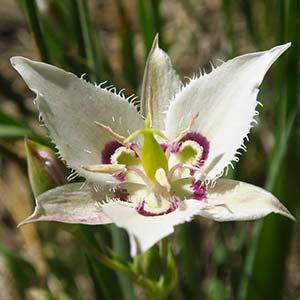Calochortus clavatus
Calochortus lyallii
club hair mariposa, clubhair mariposa lily, slender mariposa lily
Lyall's mariposa-lily
slender or coarse, stout, branching or not, strongly flexuous, 3–10 dm.
not branching or with branch in axil of cauline leaf, straight, 1–5 dm.
basal withering, 1–2 dm;
blade linear.
basal solitary, persistent, 1–3 dm × 2–20 mm, usually not exceeding inflorescence;
blade tapering toward both ends.
subumbellate, 1–6-flowered;
bracts 4–8 cm, bases dilated.
subumbellate, 1–9-flowered;
bracts 2–several, lanceolate to linear, attenuate, unequal, 1–5 cm;
peduncle slender, becoming stiffly erect in fruit.
erect;
perianth open, cup-shaped;
sepals usually with red-brown blotch at base, lanceolate-ovate, 2–4 cm, apex acute;
petals lemon to golden yellow, with transverse line distal to gland, broadly cuneate to obovate, 3–5 cm;
glands round, deeply depressed, densely covered with short hairs with branching, coralline tips, surrounded by conspicuously fringed membrane and club-shaped hairs;
filaments ca. 10 mm;
anthers purplish brown, oblong, 4–10 mm.
erect or spreading;
perianth open, campanulate;
sepals white or purplish-tinged, usually with purple crescent, lanceolate, usually equaling petals, often adaxially papillose, apex acuminate to attenuate;
petals white or purplish-tinged, usually with median, red-purple, adaxial crescent distal to gland, ovate to lanceolate, abruptly contracted at base into short, conspicuous claw, usually conspicuously fringed with long, slender hairs, adaxial surface ± papillose, bearing a few long hairs distal to claw, apex acute to acuminate;
glands transversely oblong, depressed, arched upward, bordered proximally by narrower, crenate membrane, with short, thick hairs toward distal margin of enclosed surface, both fringe of lower membrane and hairs densely long-papillose;
filaments basally dilated, ± equaling anthers;
anthers oblong-lanceolate, apex acute to short-apiculate.
erect, lanceoloid-linear, angled, 6–9 cm, apex acuminate.
erect, 3-winged, ellipsoid, base and apex acute.
light yellow, translucent, flat.
irregular.
= 16.
= 20.
Calochortus clavatus
Calochortus lyallii
Varieties 5 (5 in the flora).
(Discussion copyrighted by Flora of North America; reprinted with permission.)
1. Petals shorter than sepals; petal glands very deeply depressed. | var. avius |
1. Petals longer than sepals; petal glands shallowly to moderately depressed. | → 2 |
2. Stems straight, slender, usually 3 dm or shorter. | → 2 |
2. Stems flexuous, coarse, usually 5–10 dm. | → 3 |
3. Petals 3–4 cm, sparsely bearded; leaves not recurved. | var. gracilis |
3. Petals 4–5 cm, bearded; leaves strongly recurved. | var. recurvifolius |
4. Petals deep yellow, hairs very knobby; anthers deep purple. | var. clavatus |
4. Petals light yellow, hairs not very knobby; anthers yellow to medium purple. | var. pallidus |


